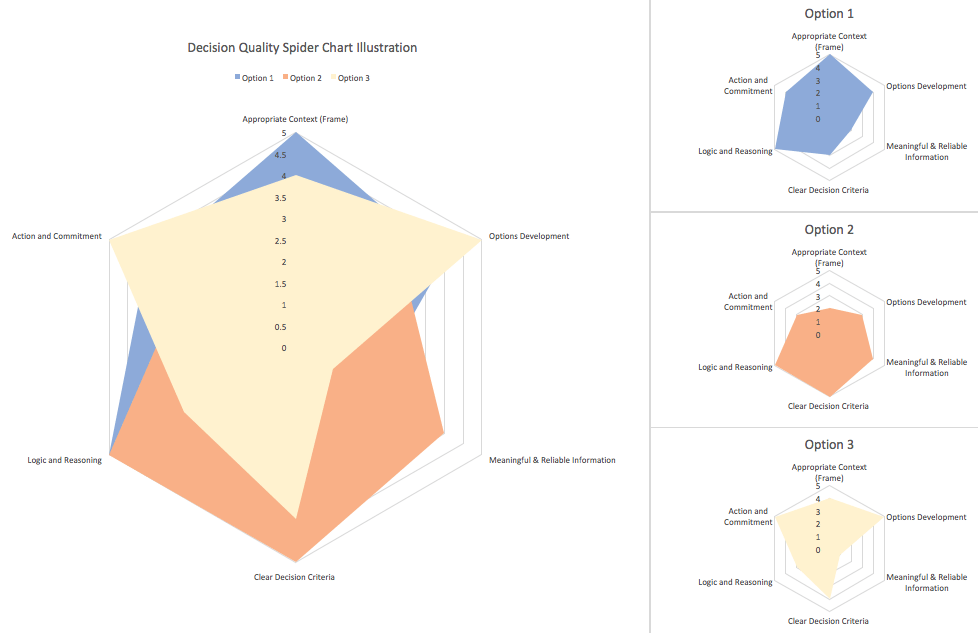
Questions to Ask If Using a Decision Quality Spider Chart (DQ Spider)
When making decisions, consider testing for decision quality (DQ)[1] so that you can avoid having another meeting. A quick method involves testing your options against your purpose to gauge alignment and support. However, this DQ Spider offers a more robust method.
First, remember that the MGRUSH technique defines consensus as a decision good enough that it ‘will be supported’ (not thwarted in the hallway or uprooted in the board room) and not cause anyone to ‘lose any sleep’ rather than being anyone’s ‘favorite’ or making them ‘happy.’ Hence, this is NOT Kum-Bah-Yah, rather we are relying on the prowess of structured facilitation.
How to Begin Using the DQ Spider
When either comparing decisions or testing for the quality of a single decision, the method remains the same. Therefore, plan on scoring and discussing six vectors that impact decision quality:
The Six Vectors[2] and Some Supporting Questions of a DQ Spider
-
Appropriate Context (Frame)
- Do you have an articulate problem to address?
- How clear is the background, context, and impact of the decision?
- How well do stakeholders commonly understand the problem?
- To what extent do stakeholders commonly prioritize the problem?
- To what extent has the decision been quantified for its impact, typically in dollars or FTP (full-time person)?
-
Options Development (NOTE: some call these ‘alternatives.’ but strictly speaking, in the English language, an alternative is one of two there are more than two, and they are called options)
- What are the possible solutions (decisions)?
- What potentially critical options are missing?
- Which inconsequential options be eliminated?
- With remaining options:
- To what extent are they realistic (doable)?
- If the option is selected, to what extent will we win?
-
Meaningful & Reliable Information
- To what extent do we know what we need to know?
- To what extent do we NOT know what we need to know?
- How trustworthy are the sources of our information?
- To what extent will this be a fact- or evidence-based decision?
-
Clear Decision Criteria (aka Values, Trade-offs, etc.)
- To what extent have we identified and clarified the most important criteria?
- How well have the criteria been prioritized to reflect our internal value drivers?
- How comprehensive are the criteria to help measure success against the project or organizational goals and objectives?
-
Logic and Reasoning
- How solid are our research, logic, and findings?
- How well can we explain our choice for and choices against our options?
- To what extent have we applied appropriate tools and rigors to evaluate this option?
-
Action and Commitment
- How confident are we projecting the outputs or outcome of this option?
- How ready are we to commit ownership and resources to this option?
- To what extent have we missed anything substantive that could impact the quality of this decision?
How to Complete the DQ Spider?
Consider this quick and simple method to capture scoring, using a low of one (1) and a high of five (5).
- Instruct each team member or stakeholder to generate their scores for the six vectors above. Thus they attribute an individual score against all remaining options.
- Using a spreadsheet or simply drawing it on a large format Post-It® paper or whiteboard, put a dot on the average value. Also place a dot for each outlier, the lowest and highest score, along each of the six vectors.
- Discuss the outliers so that everyone can support the original average, or move the average value either lower or higher based on the discussion and consensual understanding.
- Facilitate discussion around comparing the results and consider the following questions:
- To what extent are the values defensible?
- Which scores appear too high or low relative to the project or initiative they are supporting? (adjust the score if necessitated)
- To what extent do the differences represent real risk or simply differences of opinion?
- You may want to force rank the six vectors if some are more important than others. Consequently, tell the group to consider the ranking during its assessment, and if necessary, change the values based on a permutation of the reduced or increased weight of each vector.
- Therefore, in our illustration above, stakeholders would favor Option 3 if Ownership and Commitment are substantially more important than logic or reliable information.
- Likewise, stakeholders would favor Option 1 if Context and Logic become more important than Criteria and Information.
NOTES:
[1] NOTE: Microsoft Excel refers to this chart as a “Radar” Chart. However, various terms are used by other consulting firms as well.
[2] A ‘dimension’ or ‘factor’ captures a single measurement while a ‘vector’ captures multiple dimensions or factors. Additionally, vectors normally capture many more than two measurements.
______
Don’t ruin your career by hosting bad meetings. Sign up for a workshop or send this to someone who should. MGRUSH workshops focus on meeting design and practice. Each person practices tools, methods, and activities daily during the week. Therefore, while some call this immersion, we call it the road to building high-value facilitation skills.
Our workshops also provide a superb way to earn up to 40 SEUs from the Scrum Alliance, 40 CDUs from IIBA, 40 Continuous Learning Points (CLPs) based on Federal Acquisition Certification Continuous Professional Learning Requirements using Training and Education activities, 40 Professional Development Units (PDUs) from SAVE International, as well as 4.0 CEUs for other professions. (See workshop and Reference Manual descriptions for details.)
Want a free 10-minute break timer? Sign up for our once-monthly newsletter HERE and receive a free timer along with four other of our favorite facilitation tools.

Terrence Metz, MBA, CSM, CSPF, PSP01, HTTO1, is the Managing Director of MG RUSH Facilitation Leadership, Training, and Meeting Design, an acknowledged leader in structured facilitation training, and author of “Meetings That Get Results – A Facilitator’s Guide to Building Better Meetings.” His FAST Facilitation Best Practices blog features nearly 300 articles on facilitation skills and tools aimed at helping others lead meetings that produce clear and actionable results. His clients include Agilists, Scrum teams, program and project managers, senior officers, and the business analyst community among numerous private and public companies and global corporations. As an undergraduate of Northwestern University (Evanston, IL) and an MBA graduate from NWU’s Kellogg School of Management, his professional experience has focused on process improvement and product development. He continually aspires to make it easier for others to succeed.
